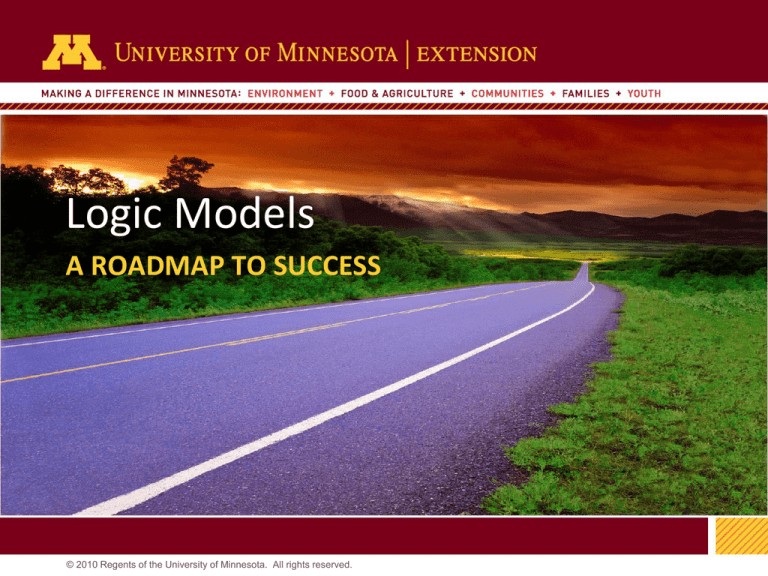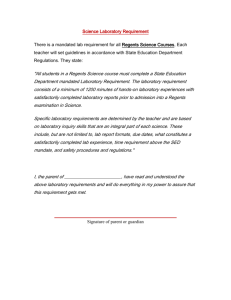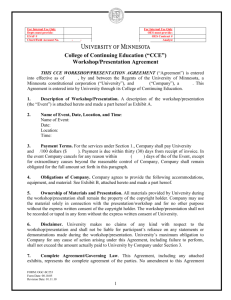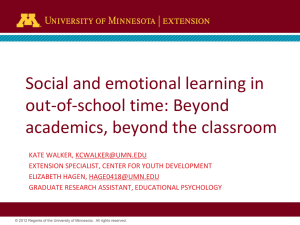
Logic Models
A ROADMAP TO SUCCESS
1
© 2010 Regents of the University of Minnesota. All rights reserved.
2
© 2010 Regents of the University of Minnesota. All rights reserved.
3
© 2010 Regents of the University of Minnesota. All rights reserved.
EVERY DAY LOGIC MODELS
DEVELOPING A LOGIC MODEL: TEACHING AND TRAINING GUIDE 2/29/2008 HANDOUT – 1
© 2008 by the Board of Regents of the University of Wisconsin System. All rights reserved.
4
© 2010 Regents of the University of Minnesota. All rights reserved.
What is the Value?
5
© 2010 Regents of the University of Minnesota. All rights reserved.
(POTENTIAL) VALUE
Builds common understanding
Clarifies project theory
Engages stakeholders
Builds ownership
Supports evaluation
6
© 2010 Regents of the University of Minnesota. All rights reserved.
What are the limitations of logic models?
7
© 2010 Regents of the University of Minnesota. All rights reserved.
It’s logical; life isn’t.
Many factors influence outcomes
Knowledge and attitudes are not the best
predictors of behaviors.
8
© 2010 Regents of the University of Minnesota. All rights reserved.
The important stuff happens between the
columns.
Are we doing the right thing?
9
© 2010 Regents of the University of Minnesota. All rights reserved.
10
11
12
©likeablerodent, Creative Commons
13
© 2010 Regents of the University of Minnesota. All rights reserved.
14
© 2010 Regents of the University of Minnesota. All rights reserved.
WHAT DO YOU INVEST IN YOUR
PROGRAM?
15
© 2010 Regents of the University of Minnesota. All rights reserved.
What staff do you have?
What volunteers?
How much time?
How much money?
What materials?
What resources? Technology?
What partnerships do you maintain?
16
© 2010 Regents of the University of Minnesota. All rights reserved.
WHAT DOES YOUR PROGRAM DO?
17
© 2010 Regents of the University of Minnesota. All rights reserved.
What services do you develop?
What resources do you develop?
What workshops do you conduct?
What counseling do you offer?
What assessments do you do?
What do you facilitate?
18
© 2010 Regents of the University of Minnesota. All rights reserved.
WHO DO YOU REACH?
19
© 2010 Regents of the University of Minnesota. All rights reserved.
What are your participants?
Who are your clients?
Who are your stakeholders?
What agencies do you work with?
Who are your customers?
Whose life changes because of your
work?
20
© 2010 Regents of the University of Minnesota. All rights reserved.
WHAT DO PEOPLE LEARN AS A
RESULT OF YOUR WORK?
21
© 2010 Regents of the University of Minnesota. All rights reserved.
What new awareness do they have?
What new skills do they possess?
What aspirations do they have after
working with you?
What motivations have they discovered
because of your work?
22
© 2010 Regents of the University of Minnesota. All rights reserved.
HOW DO PEOPLE BEHAVE DIFFERENTLY
AFTER PARTICIPATING IN YOUR WORK?
23
© 2010 Regents of the University of Minnesota. All rights reserved.
What new behaviors do they have?
What new practices do they have?
What decisions do they now routinely
make because of your work?
24
© 2010 Regents of the University of Minnesota. All rights reserved.
WHAT CONDITIONS IN THE COMMUNITY
CHANGE BECAUSE OF YOUR WORK?
25
© 2010 Regents of the University of Minnesota. All rights reserved.
What social conditions change?
What economic conditions change?
What civic conditions change?
26
© 2010 Regents of the University of Minnesota. All rights reserved.
©bengrey, Creative Commons
27
© 2010 Regents of the University of Minnesota. All rights reserved.
28
© 2010 Regents of the University of Minnesota. All rights reserved.
TIPS FOR ACTIVITIES…
Details are important
Too broad:
– Conduct outreach to faculty, families and local
community
Better:
– Meet with school faculty and administrators
– Place information about Center in school and local
newspapers
– Conduct telephone outreach to families of nonenrolled students
29
© 2010 Regents of the University of Minnesota. All rights reserved.
TIPS FOR OUTPUTS…
Too broad:
– Maintain existing services
Better:
–
–
–
–
Conduct intake and screening for 40 students
Connect 20 students/families to health insurance
Provide acute medical care to students
Provide 50 immunizations to students
30
© 2010 Regents of the University of Minnesota. All rights reserved.
SMART OUTCOMES
Consider the scope of your resources and
activities
Don’t set yourself up!
31
© 2010 Regents of the University of Minnesota. All rights reserved.
© Mado.image, Creative
Commons
32
© 2010 Regents of the University of Minnesota. All rights reserved.
“Not how many worms the
bird feeds its young, but how
well the fledgling flies.”
(United Way of America, 1999)
©Ben Saren, Creative Commons
33
© 2010 Regents of the University of Minnesota. All rights reserved.
CHECK YOUR LOGIC MODEL
1.
2.
3.
4.
Is it meaningful?
Does it make sense?
Is it doable?
Can it be verified?
34
35
Don’t reinvent
the wheel
www.uwex.edu/ces/lmcourse
36
© 2010 Regents of the University of Minnesota. All rights reserved.
37
© 2010 Regents of the University of Minnesota. All rights reserved.
WHAT GETS MEASURED GETS DONE
If you don’t measure results, you can’t tell success from
failure
If you can’t see success, you can’t reward it
If you can’t reward success, you’re probably rewarding
failure
If you can’t see success, you can’t learn from it
If you can’t recognize failure, you can’t correct it.
If you can demonstrate results, you can win public
support.
Re-inventing government, Osborne and Gaebler, 1992
38
© 2010 Regents of the University of Minnesota. All rights reserved.
Thank you.
samgrant@umn.edu
© 2010 Regents of the University of Minnesota. All rights reserved.
The University of Minnesota is an equal opportunity educator and employer. In accordance with the Americans with Disabilities
Act, this PowerPoint is available in alternative formats upon request. Direct requests to the Extension Store at 800-876-8636.
39








